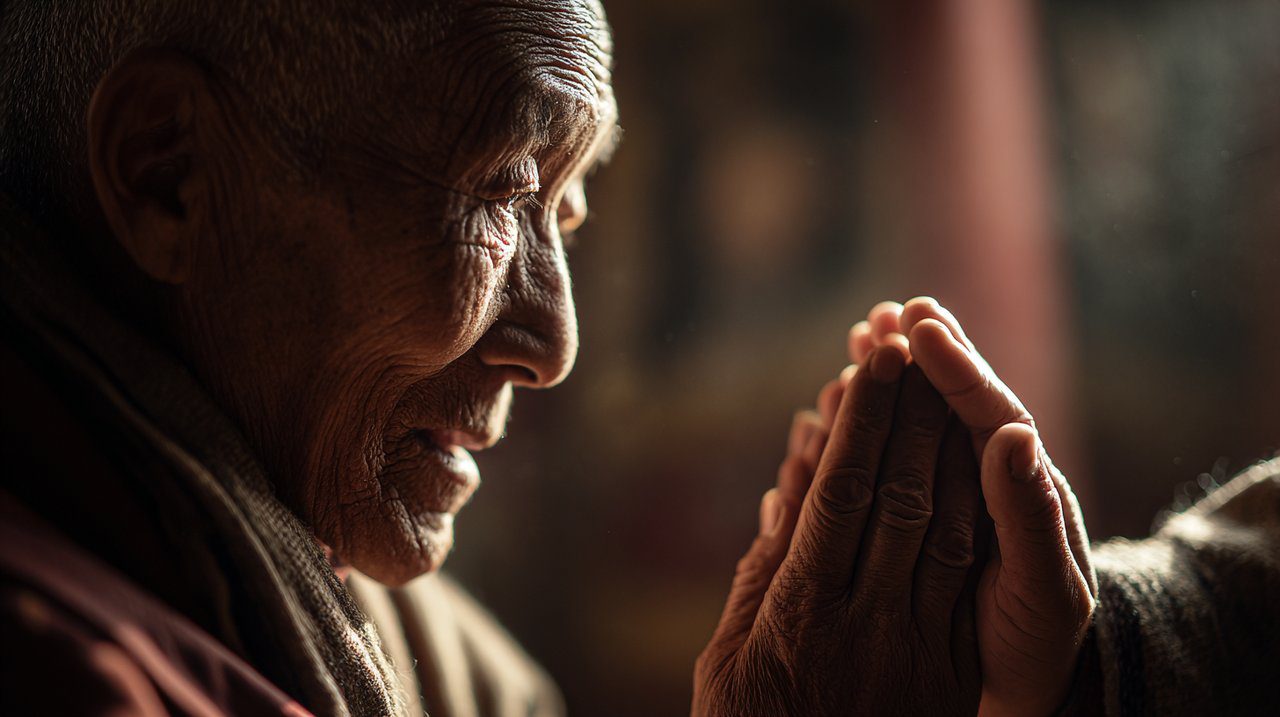The Silent Weave: Unveiling the Khata’s Philosophical Heart
In the quiet of a misty dawn, just before a monastery gate, a small gathering stands. Their hands, though empty of words, hold something else: a crisp white fabric, carefully folded.
There is a silent anticipation, a quiet reverence in their eyes. This moment, so simple, speaks volumes about the Khata, a silken scarf that carries more than just threads.
It is a whisper of the heart, a gentle bridge between souls. This humble cloth, in its very stillness, reflects a profound way of seeing the world, much like a solitary stone holding the memory of ages. It is a silent communication, a dialogue of pure intention.

The Silent Language of Silk: Echoes of the Heart
A Thread of Auspiciousness: The Core Meaning of Khata
The Khata is a ceremonial scarf, often made of silk, presented with deep respect in Tibetan culture. It is not merely a gift, but a physical manifestation of purity, goodwill, and auspiciousness.
The act of offering a Khata symbolizes a clean heart and sincere intentions. Like a clear mountain spring, its essence is unblemished, flowing with blessings.
It expresses a connection that transcends spoken words, a silent promise of peace and honor. It is a gentle current of good wishes, moving from one heart to another.
From Ancient Roots: A Brief History of Khata
The tradition of offering Khatas stretches back centuries, woven into the fabric of Tibetan history and spiritual practice. Initially, rougher fabrics might have been used, slowly evolving into the delicate silk we see today.
This practice became a universal gesture of greeting, farewell, and respect across all strata of society. Just as a river carves its path through time, shaping the landscape, the Khata tradition has shaped interactions.
It is a silent prayer, much like the rhythmic turning of Tibetan prayer wheels. Each revolution is a wordless offering of devotion and intention, carrying wishes on the wind.
A Spectrum of Reverence: Decoding Khata Colors and Their Wisdom
White: The Purity of Intention and New Beginnings
The most common Khata is white, symbolizing purity, truth, and genuine intentions. It represents an unblemished heart, ready for new beginnings and sincere connections.
It is the color of fresh snow on untouched peaks, reflecting light and clarity. It speaks of a clean slate, a quiet promise.
Blue: The Vastness of the Sky and Spiritual Realization
Blue Khatas echo the boundless sky and the vastness of the ocean. They represent spiritual realization and the awakening of compassion.
This color often signifies a connection to higher consciousness and the infinite. It is like gazing into a deep, clear lake, reflecting the heavens above.
Yellow: The Earth’s Abundance and Royal Majesty
Yellow Khatas reflect the fertile earth, abundance, and the golden rays of the sun. It is a color associated with royalty, prosperity, and the wisdom of the Buddha.
It reminds us of a field of ripe grain, full of life’s quiet bounty.
Red: The Fire of Compassion and Life Force
Red signifies the warmth of compassion, the vibrant life force, and the energy of transformation. It is a powerful color, often used to express deep love and protective energy.
Like the glowing embers of a hearth, it speaks of enduring warmth and vitality.
Green: The Growth of Enlightenment and Harmony
Green Khatas represent growth, harmony, and the flourishing of enlightened activity. They embody the natural world’s constant renewal and the promise of peace.
It is the gentle unfolding of a new leaf, full of quiet potential. These colored silks, each with its distinct resonance, are akin to healing crystals.
Both serve to focus and transmit positive aspirations, connecting us to deeper meanings, much like a quiet stream channels the mountain’s essence.
The Dance of Giving and Receiving: Khata’s Traditional Gestures
Welcoming and Farewell: Honoring Guests and Travelers
The Khata is frequently offered to guests upon arrival and departure, a gesture of warm welcome and safe passage. It is draped gently around the neck, a soft embrace of hospitality.
The act is a silent blessing, wishing well on a journey, whether physical or spiritual. It’s a quiet send-off, like the wind guiding a fallen feather.
Blessings and Offerings: Sacred Ceremonies and Rituals
Within monasteries and at sacred sites, Khatas are offered to deities, lamas, and revered teachers. They are placed at altars, symbolizing devotion and seeking spiritual blessings.
This act is a profound expression of faith, a visible pledge of reverence. It is a quiet moment of connection, much like the stillness found within an ancient forest.
Milestones and Transitions: Celebrating Life’s Journeys
From births to weddings, and even funerals, Khatas mark significant life events. They signify congratulations, comfort, or respect during transitions.
It’s a way to acknowledge the impermanence of things while honoring the moment, like the changing seasons marking life’s quiet progression. The exchange of Khatas in these rituals is much like the use of mala beads in meditation.
Both are integral to Tibetan spiritual practice, often used in contexts of offerings, blessings, or as personal spiritual tools, carrying the energy of intention and mindful presence.
Beyond the Fabric: Khata as a Reflection of Inner Stillness
The Unspoken Bond: Building Trust and Connection
The true power of the Khata lies not in its material, but in the pure intention it carries. When an elder, with eyes full of quiet wisdom, places a Khata around a young person’s neck, there are no elaborate speeches.
The gaze, the gentle touch, the simple act itself, transmit a warmth, a legacy of care and trust that words often fail to convey. It is a silent dialogue of the heart, building bonds without sound.
The clearest communication often happens in silence, where intentions are felt, not just heard.

A Mirror to the Heart: The Philosophy of Intentional Giving
The Khata reminds us of the profound beauty in intentional giving and receiving. It is a practice of humility and gratitude, reflecting the giver’s pure heart and the recipient’s open spirit.
This mirrors the natural world: the morning dew gives itself freely to nourish the earth, and the ancient mountains silently accept the wind and rain, shaping their form without complaint.
Like the mysterious patterns on Dzi beads, each Khata carries a unique story of connection and blessing, imbued with potent cultural and spiritual significance. Both are revered objects, often received as symbols of protection or as profound gifts, each holding a silent, timeless wisdom within its form.
The Khata, in its simple elegance, serves as a powerful, silent language in Tibetan culture. Its colors speak of deep symbolism, and its presentation marks moments of respect, blessing, and transition.
It is a testament to how profound meaning can be woven into the most unassuming forms. Just as the quiet dawn mist eventually lifts to reveal the clear mountain, the Khata reveals the pure heart of human connection.
It reminds us that the deepest respect, the truest blessings, and the most enduring bonds often reside not in grand pronouncements, but in the quiet, intentional gestures that echo the unchanging cycles of nature.
Perhaps, in our own lives, we might find similar ways to offer our pure intentions, to connect with others through simple, heartfelt expressions, and to explore other crafts that carry such profound stories and spirit.
💡 Pertanyaan yang Sering Diajukan
The white Khata, the most common type, primarily symbolizes purity, truth, and genuine intentions. It represents an unblemished heart and is used to signify new beginnings and sincere connections, much like fresh snow on untouched peaks.
Different Khata colors carry distinct meanings: Blue represents the vastness of the sky and spiritual realization; Yellow signifies the earth's abundance and royal majesty; Red embodies the fire of compassion and life force; and Green symbolizes growth, harmony, and enlightened activity.
Khatas are traditionally offered in various contexts, including welcoming guests and bidding farewell, as a gesture of hospitality and safe passage. They are also presented during sacred ceremonies and rituals to deities, lamas, and revered teachers as a symbol of devotion and to seek spiritual blessings. Furthermore, Khatas mark significant life milestones and transitions such as births, weddings, and funerals, signifying congratulations, comfort, or respect.
The deeper philosophical significance of the Khata lies in its ability to convey pure intention and build trust and connection without words. It embodies the beauty of intentional giving and receiving, reflecting humility, gratitude, and the giver's pure heart and the recipient's open spirit. It serves as a silent dialogue of the heart, forging bonds through felt intentions rather than spoken words.








